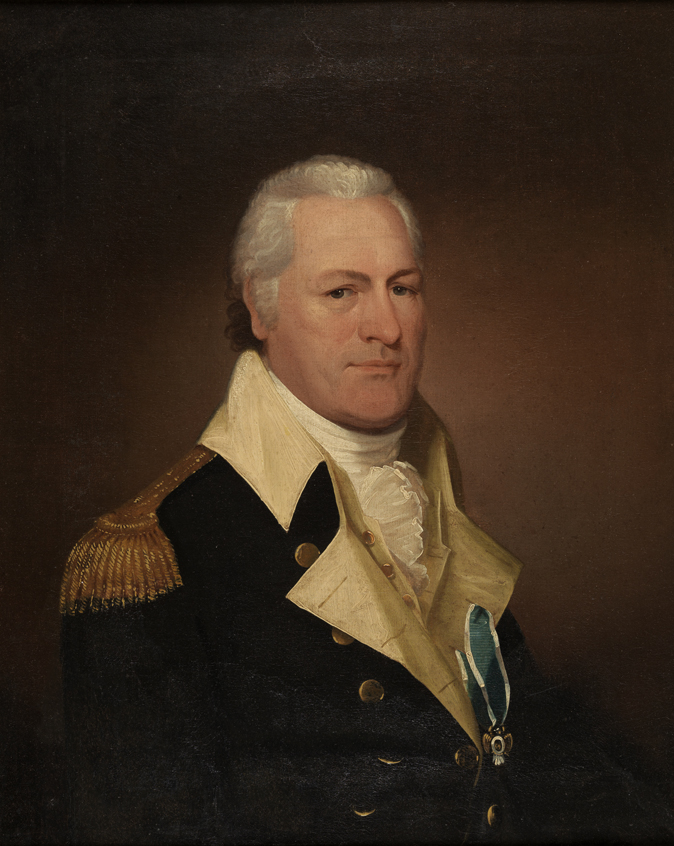Two Lieutenants and the Battle of Brooklyn
On the afternoon of 27 Aug 1776, British and Hessian soldiers under Gen. James Grant advanced on a Continental force, including men from Delaware and Maryland, under Gen. William Alexander, Lord Stirling (shown here).
Lt. John Ragg of the British marine grenadiers led twenty men forward from the right flank of the Crown forces. His orders were “to speak to” the commander of a unit in blue coats, thought to be Hessians, and tell them to stop firing at their own side.
Meanwhile, Lt. William Popham was one of the American officers trying to hold the left side of their line with a company of “awkward Irishmen and others.” Coming from the Delaware regiment, those soldiers were dressed in blue coats.
You can guess what happened. As Popham told it, “Capt. Wragg [sic] and 18 men, supposing us to be Hessians by the similarity of our dress, approached too near before he discovered his mistake.”
The Delaware Continentals took the marines as prisoners. The Americans stripped the British of their guns, Popham taking charge of Ragg’s weapons.
Decades later Popham reported:
As the party crossed the meadow, the British started to fire cannon in their direction. Lt. Ragg stopped moving, “in the hope of a rescue.”
Popham ordered Ragg to “march forward instantly, or I should fire on him.”
Ragg started moving again. But then a new obstacle appeared:
Gen. William Howe had sent many more of his troops on long flanking march to the right. They moved through an unguarded pass and hit the Americans from an unexpected direction. In fierce fighting, almost the whole Continental force was driven back to Brooklyn Heights.
Stirling ordered most of his men back as well, keeping a contingent of Maryland soldiers as the rear guard. He led them in two counterattacks on the Crown forces while other Americans withdrew as best they could.
At the end of the day, the Continentals had lost more than 2,000 men. Nearly all the Maryland rear guard was dead. Stirling was a prisoner.
Gen. Howe reported 64 killed, 293 wounded, and 31 missing—including Lt. Ragg and his marines.
TOMORROW: The end of Lt. Ragg’s war?
Lt. John Ragg of the British marine grenadiers led twenty men forward from the right flank of the Crown forces. His orders were “to speak to” the commander of a unit in blue coats, thought to be Hessians, and tell them to stop firing at their own side.
Meanwhile, Lt. William Popham was one of the American officers trying to hold the left side of their line with a company of “awkward Irishmen and others.” Coming from the Delaware regiment, those soldiers were dressed in blue coats.
You can guess what happened. As Popham told it, “Capt. Wragg [sic] and 18 men, supposing us to be Hessians by the similarity of our dress, approached too near before he discovered his mistake.”
The Delaware Continentals took the marines as prisoners. The Americans stripped the British of their guns, Popham taking charge of Ragg’s weapons.
Decades later Popham reported:
I was immediately ordered with a guard to convey them across the creek in our rear to our lines. On descending the high ground we reached a salt meadow, over which we passed, though not miry, yet very unfavorable to silk stockings and my over-clothes.Popham was a Princeton College graduate eager to look like a gentleman.
As the party crossed the meadow, the British started to fire cannon in their direction. Lt. Ragg stopped moving, “in the hope of a rescue.”
Popham ordered Ragg to “march forward instantly, or I should fire on him.”
Ragg started moving again. But then a new obstacle appeared:
When we got to the creek, the bank of which was exceedingly muddy, we waded up to our waists. I got in after my people and prisoners, and an old canoe that had been split and incapable of floating except by the buoyancy of the wood, served to help those who wanted help to cross a deep hole in the creek, by pushing it across from the bank which it had reached.Gen. Grant continued to press forward with his 7,000 men, more than twice the British force in the Battle of Bunker Hill. However, that was just a diversion.
I had advanced so far into the mud, and was so fatigued with anxiety and exercise, that I sat down on the mud with the water up to my breast, Wragg’s fusee, cartouch-box, and bayonet on my shoulder; in which situation I sat till my charge were all safely landed on the rear.
Gen. William Howe had sent many more of his troops on long flanking march to the right. They moved through an unguarded pass and hit the Americans from an unexpected direction. In fierce fighting, almost the whole Continental force was driven back to Brooklyn Heights.
Stirling ordered most of his men back as well, keeping a contingent of Maryland soldiers as the rear guard. He led them in two counterattacks on the Crown forces while other Americans withdrew as best they could.
At the end of the day, the Continentals had lost more than 2,000 men. Nearly all the Maryland rear guard was dead. Stirling was a prisoner.
Gen. Howe reported 64 killed, 293 wounded, and 31 missing—including Lt. Ragg and his marines.
TOMORROW: The end of Lt. Ragg’s war?


